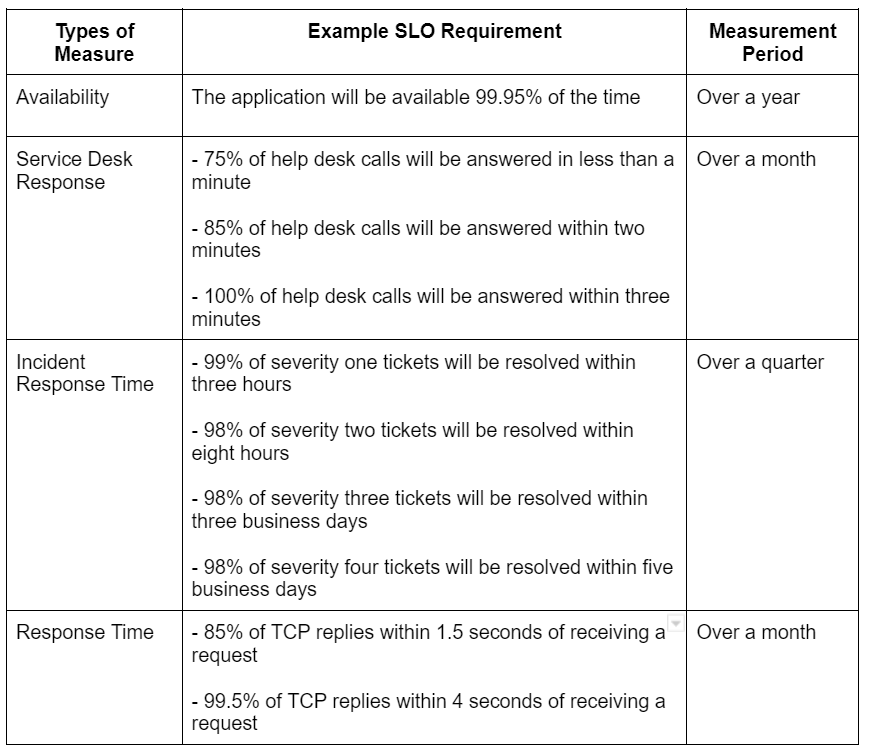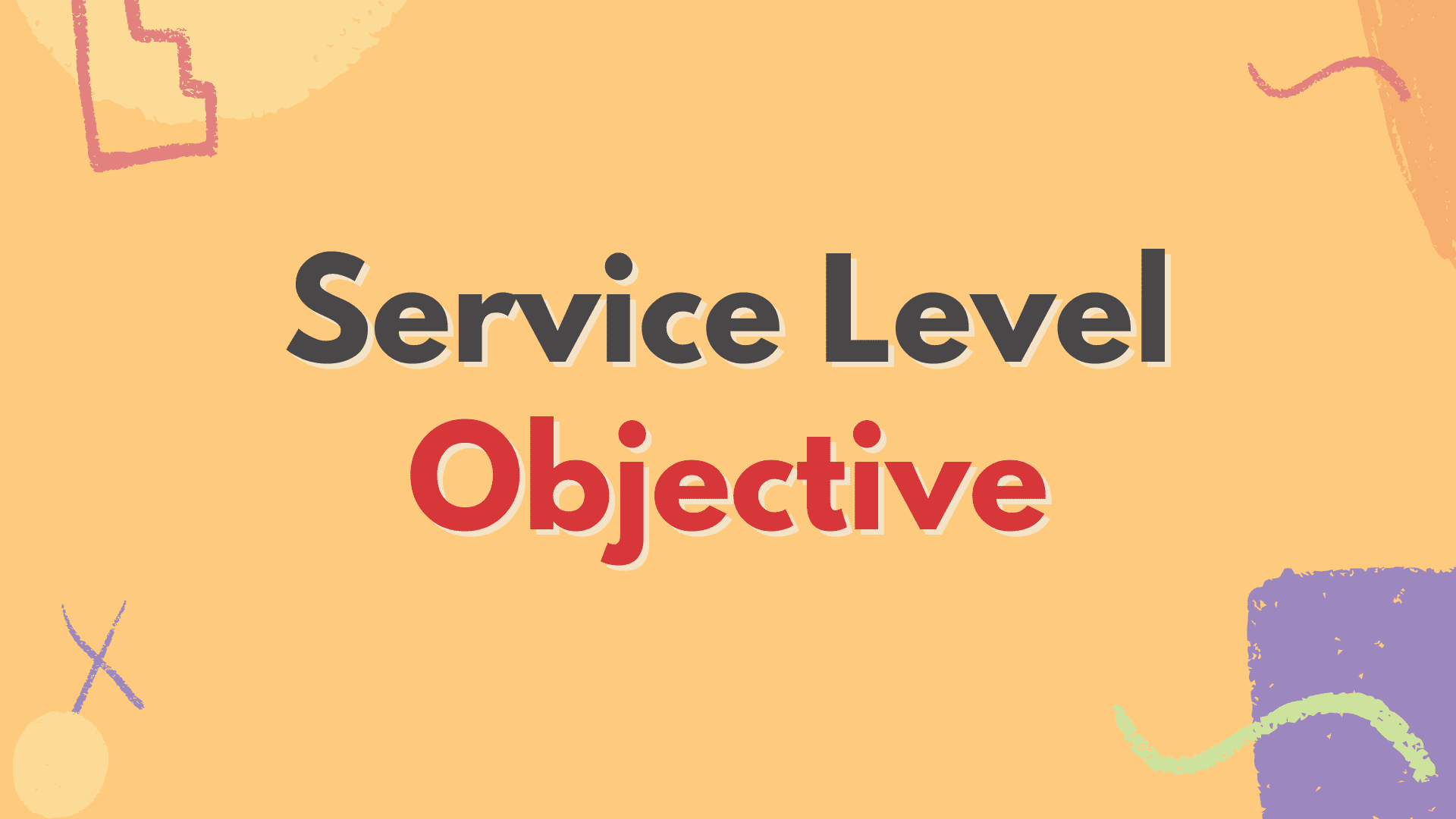Service Level Objective (or SLO) has a crucial role in business performance.
Businesses face issues when customers lose trust in the brand due to poor performance of any business unit. For instance, an online business can have services to enable cart payment processing, email receipt triggering, order fulfillment, delivery time, etc. The business will lose money and customers if all these services do not perform well.
Customer satisfaction is the foundation of business sustainability; therefore, it should be the top priority of businesses.
In the competitive market, having a solid Service Level Objective (SLO) increases the chances of business growth.
What is a Service Level Objective (SLO)?
SLOs help measure the service provider’s performance. In addition, it minimizes misunderstandings between customers and service providers, leading to fewer disagreements.
An SLO quantifies the expectations of customers. This initiates discussions between the product and engineering teams about reliability objectives and backup plans when an SLO is in jeopardy.
A service’s SLO can be 96% over four weeks, as 100% SLO means complete perfection and will have no further room for improvement. Therefore, expecting flawless reliability is equivalent to preventing innovation.
If clients are satisfied, it will build trust and increase brand loyalty.
It is unwise to keep increasing SLO targets continuously. The objective is to satisfy clients rather than achieve perfection. Additional trustworthiness has less significance if clients are happy with the current status of service.
What is the Purpose of an SLO?
The purpose of SLO is to assess customer satisfaction, defend the business from SLA breaches, and develop a common concept of reliability among the engineering, product, and business management team.
Customers seek products and services that strike the ideal balance between trustworthiness and production. They want functionality and the flexibility to use features whenever they wish. Also, to increase income, businesses must keep the existing customer, expand into the new market and develop new products.
For example, recruiting companies promise clients 99.9% service by providing the best talent/ resources when required. Businesses can create a service level agreement (SLA) to respond to requests within two hours. In addition to the quality of services, SLAs define what steps, actions, or efforts customers can take when SLAs are not delivered.
How to Define the SLO?
Defining SLOs for service is a time-consuming process as it is unique to each business.
The SLO is the consumer’s desired level of service reliability. It must be attainable and shows the effectiveness of the technological sensibility of the firm. To maintain client satisfaction, the SLO must be high enough but attainable. The SLO evolves with the system.
Indicate the SLO’s overall success rate as a percentage. For example, an SLO never aims to be 100%; instead, it intends to be near 100%.
Measuring the metrics, or service level indicator (SLI), is necessary to define the SLO. However, you primarily measure the SLI from the consumer’s point of view.
The definition process for SLO and SLI can be repetitive. However, unlike SLIs, which are by the available measurement, SLOs are by the needs of the business. Therefore, they can be different during the first iteration.
The table below lists several measurement criteria or techniques to define the SLO.

Who Defines the SLO?
The SRE (Site Reliability Engineering) team defines the SLO in collaboration with other relevant stakeholders.
The principal parties involved are:
- Product owners convey consumer demands to the SRE and development teams to add to the SLO definition.
- Infrastructure engineers provide the foundation for the development team, DevOps ITSM, and problem management. In addition, they ensure that the SLO is reasonable, sustainable, and free of unnecessary effort.
- The software team creates the software product. If reliability efforts are slowing the release, they can negotiate a relaxation.
- Customers include users and stakeholders. Feedback sessions, customer grievances, tweets, and SLAs, help define SLO.
What are the Characteristics of an SLO?
An SLO should correspond to the unique business requirements. For example, if clients operate in the same location, accessibility outside office timing would not be a concern. In addition, since the customer would not use the service, they would not be upset if it malfunctions during off time.
A well-defined SLO should have authenticity. Choose an SLO considering the resource limitations and the past performance of the services. Businesses should be careful and not frustrate the team by setting an impossible goal.
Challenges in Creating an SLO
The following are a few challenging of creating an SLO:
- The team will become anxious and frustrated if the SLOs lack clarity, which could result in brain-crunching.
- Commencing many SLOs at once can exhaust team members. The best strategy is to begin small and grow gradually.
- Not leaving space for error. Aiming for perfect precision is unrealistic and will prevent business growth.
How often is the SLO Evaluated?
A regular review of SLO is crucial because it shows if the customers are unsatisfied. No rule determines the SLO review frequency, but it is good practice to review it every month. Then, follow up with a comparable review every three to six months.
Each organization has varied SLOs depending on the product, anticipated consumption, etc.
Find areas lacking performance and improve targets. Consider investing in product development or experimentation with the unused error budget. Before releasing new components, stabilize the product.
They continually assess SLOs and focus on understanding, creating, and reversing courses.
Consequences of Not Meeting an SLO
SLOs are targets established to have consistent system behavior. A system may experience performance deterioration, outages, or customer impact if an SLO is not met.
All teams involved must agree on the repercussions of not meeting the SLOs. SREs can use the error budget policies to notify leaders when the SLO is unmet. For instance, if the SLO is 96%, informing the leaders at 93% can assist them in taking appropriate action and give reliability a higher priority than feature speed.
Examples of Service Level Objectives (SLO)
According to Sturm and Morris, SLOs must be:
- Attainable
- Repeatable
- Measurable
- Understandable
- Meaningful
- Controllable
- Affordable
- Universally agreeable

What is the Difference between SLA, SLI, and SLO?
The SLA, SLO, and SLI are interconnected. The difference between them are as follows:
- SLA is an agreement between the service provider and the client to provide service performance.
- They must achieve the SLO for high-quality SLA.
- SLI helps measure the SLO.
Customers have high expectations for free and paid services.
Businesses must uphold SLAs and SLOs and stand for business commitments to customers. These internal parameters assist businesses in achieving goals, and measurable outcomes show the performance.
All three initiatives help get service providers and consumers on one page regarding service performance. For example, customers are interested in knowing the time a business will take to respond to a system failure, the guarantees for functionality and speed, etc.
Service Level Agreements (SLAs) define the services given to clients, how they will be assisted, when and where they will be delivered, the cost, who is the accountable person, etc. It is the agreement between the customer and the service provider that serves the promises to clients and the repercussions of avoiding promises. Consequences frequently take the form of payments.
Service Level Indicators (SLIs) measure the service level offered by a service provider to a consumer. This includes error rate, throughput, availability, latency, durability, etc.
SLIs are the foundation for service level objectives (SLOs), which serve as the foundation for service level agreements (SLAs). An SLI is also known as an SLA metric.
Conclusion
A business should provide high-quality services to its clients. SLO stands for service level objective, set by the consumer, and a consensus reached by the project team and the organization. Achieving SLO ensures the clients are receiving services as expected.
